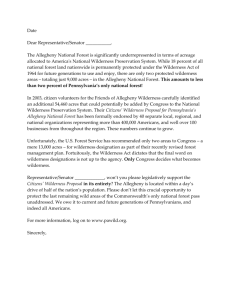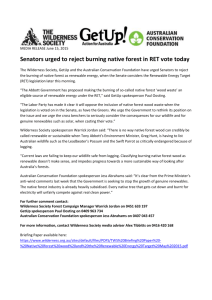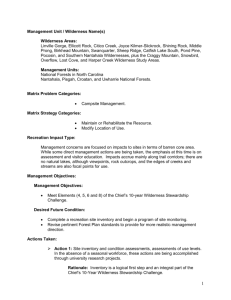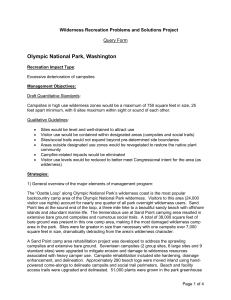Aircraft Wreckage Removal Standards
advertisement
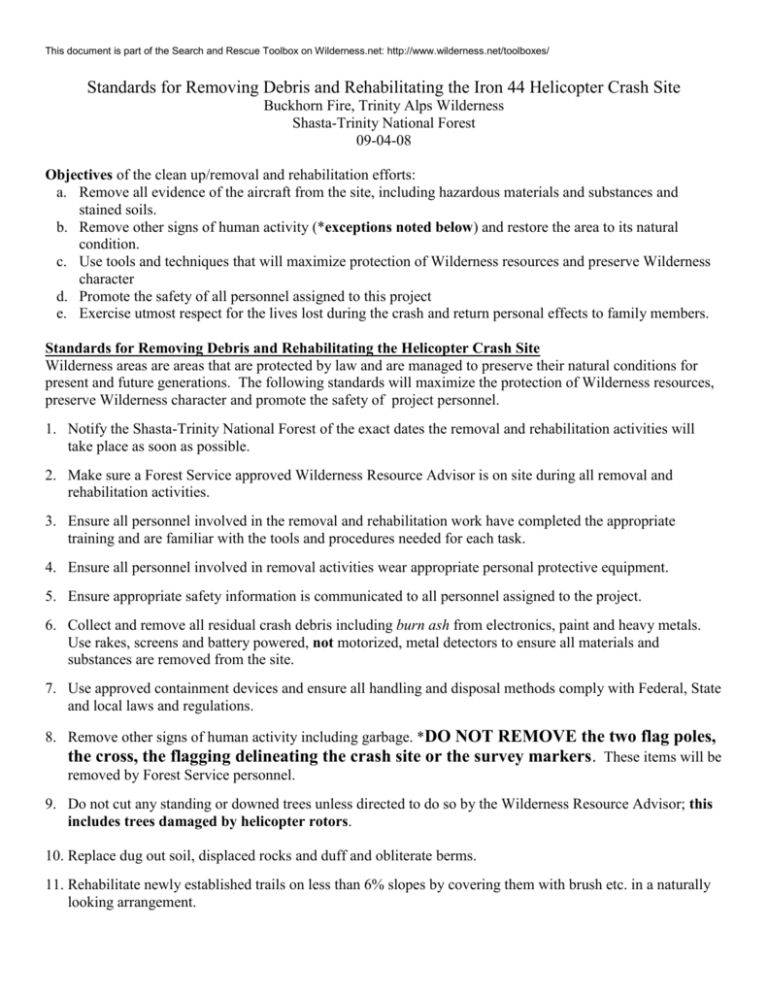
This document is part of the Search and Rescue Toolbox on Wilderness.net: http://www.wilderness.net/toolboxes/ Standards for Removing Debris and Rehabilitating the Iron 44 Helicopter Crash Site Buckhorn Fire, Trinity Alps Wilderness Shasta-Trinity National Forest 09-04-08 Objectives of the clean up/removal and rehabilitation efforts: a. Remove all evidence of the aircraft from the site, including hazardous materials and substances and stained soils. b. Remove other signs of human activity (*exceptions noted below) and restore the area to its natural condition. c. Use tools and techniques that will maximize protection of Wilderness resources and preserve Wilderness character d. Promote the safety of all personnel assigned to this project e. Exercise utmost respect for the lives lost during the crash and return personal effects to family members. Standards for Removing Debris and Rehabilitating the Helicopter Crash Site Wilderness areas are areas that are protected by law and are managed to preserve their natural conditions for present and future generations. The following standards will maximize the protection of Wilderness resources, preserve Wilderness character and promote the safety of project personnel. 1. Notify the Shasta-Trinity National Forest of the exact dates the removal and rehabilitation activities will take place as soon as possible. 2. Make sure a Forest Service approved Wilderness Resource Advisor is on site during all removal and rehabilitation activities. 3. Ensure all personnel involved in the removal and rehabilitation work have completed the appropriate training and are familiar with the tools and procedures needed for each task. 4. Ensure all personnel involved in removal activities wear appropriate personal protective equipment. 5. Ensure appropriate safety information is communicated to all personnel assigned to the project. 6. Collect and remove all residual crash debris including burn ash from electronics, paint and heavy metals. Use rakes, screens and battery powered, not motorized, metal detectors to ensure all materials and substances are removed from the site. 7. Use approved containment devices and ensure all handling and disposal methods comply with Federal, State and local laws and regulations. 8. Remove other signs of human activity including garbage. *DO NOT REMOVE the two flag poles, the cross, the flagging delineating the crash site or the survey markers. These items will be removed by Forest Service personnel. 9. Do not cut any standing or downed trees unless directed to do so by the Wilderness Resource Advisor; this includes trees damaged by helicopter rotors. 10. Replace dug out soil, displaced rocks and duff and obliterate berms. 11. Rehabilitate newly established trails on less than 6% slopes by covering them with brush etc. in a naturally looking arrangement. 12. If newly created trails were constructed into the crash site on slopes greater than six percent, construct waterbars according to the following Guide. Waterbar Spacing Guide Trail Percent grade 6-9 10-15 15-25 25+ Maximum Spacing in Feet 400 200 100 50 13. Where soil has been exposed and compacted, such as on trails, at helispots etc., scarify the top 2-4 inches and scatter with needles, twigs, rocks and dead branches. Do not use non-native seed or fertilizer. 14. Cut the stumps of the trees that were felled to allow for the removal of the helicopter wreckage as close to the ground as possible. Chop the surface of these stumps with an axe or Pulaski. This will make the surface jagged and rough will speed decomposition. Camouflage rough stumps and tree boles using rocks, dead woody material, soil and fallen or broken green branches. 15. It may be necessary to buck the fallen trees and disperse the rounds. Consult the Resource Advisor. 16. Drag other highly visible woody debris (limbs, etc.) into timbered areas and disburse. Material that has been cut and is too large to move should be cut at a slant so a minimal amount of the cut surface is exposed to view. 17. Drag the highly visible woody debris (limbs, etc.) that has been stacked/piled around the H44 helispot into timbered areas to disburse so it can decompose more naturally. This stacked vegetation was created when the helispot was widened to accommodate investigation teams and to facilitate the removal of the helicopter wreckage. 18. Use the attached Leave No Trace principles while on site. 19. Naturalize the area before leaving the site. 20. The use of mechanical transport (helicopter) will be allowed for the removal of hazardous materials, including fuel stained soil. It has been estimated that the amount of contaminated soil on site will fit into one sling load. No more than one helicopter trip into the site will be allowed without a separate request for helicopter use that will need to be approved by the Forest Supervisor. 21. The use of mecahnical transport (helicopter) can also be used to transport clean up and rehabilitation personnel to the site if done in conjunction with the trip into the site to remove hazardous materials. A strategy should be developed to optimize and minimize flight time. 22. Schedule the use of mechanical transport (helicopter) for a Monday, Tuesday, Wednesday or Thursday to minimize impacts to wilderness visitors. 23. Any remaining debris that wasn’t flown out with the hazardous materials will need to be hiked/backpacked out or packed out using commercial packers (using horses or mules) via the Green Mountain trail (12W09). The vendor will be responsible for making arrangements to pick up personnel at the Green Mountain trailhead and/or with commercial packers. 24. The Green Mountain trailhead can be accessed using the French Creek Road (5N13 to 6N04) off Highway 299. The crash site is approximately six miles from the Green Mountain trailhead. 25. It will likely be necessary for the clean up and rehabilitation crew to spend at least one night at the site. Camping gear and provisions (food, water, warm clothing, etc.) will need to be provided by the vendor. Project Completion The Forest Service Wilderness Resource Advisor will notify the forest contact and/or Contracting Officer when the removal of materials and the site rehabilitation work has been satisfactorially completed. LEAVE NO TRACE PRINCIPLES Plan Ahead and Prepare Know the regulations and special concerns for the area you'll visit. Prepare for extreme weather, hazards, and emergencies. Schedule your trip to avoid times of high use. Visit in small groups when possible. Consider splitting larger groups into smaller groups. Repackage food to minimize waste. Use a map and compass to eliminate the use of marking paint, rock cairns or flagging. Travel and Camp on Durable Surfaces Durable surfaces include established trails and campsites, rock, gravel, dry grasses or snow. Protect riparian areas by camping at least 200 feet from lakes and streams. Good campsites are found, not made. Altering a site is not necessary. In popular areas o Concentrate use on existing trails and campsites. o Walk single file in the middle of the trail, even when wet or muddy. o Keep campsites small. Focus activity in areas where vegetation is absent. In pristine areas o Disperse use to prevent the creation of campsites and trails. o Avoid places where impacts are just beginning. Dispose of Waste Properly Pack it in, pack it out. Inspect your campsite and rest areas for trash or spilled foods. Pack out all trash, leftover food, and litter. Deposit solid human waste in catholes dug 6 to 8 inches deep at least 200 feet from water, camp, and trails. Cover and disguise the cathole when finished. Pack out toilet paper and hygiene products. To wash yourself or your dishes, carry water 200 feet away from streams or lakes and use small amounts of biodegradable soap. Scatter strained dishwater. Leave What You Find Preserve the past: examine, but do not touch, cultural or historic structures and artifacts. Leave rocks, plants and other natural objects as you find them. Avoid introducing or transporting non-native species. Do not build structures, furniture, or dig trenches. Minimize Campfire Impacts Campfires can cause lasting impacts to the backcountry. Use a lightweight stove for cooking and enjoy a candle lantern for light. Where fires are permitted, use established fire rings, fire pans, or mound fires. Keep fires small. Only use sticks from the ground that can be broken by hand. Burn all wood and coals to ash, put out campfires completely, then scatter cool ashes. Respect Wildlife Observe wildlife from a distance. Do not follow or approach them. Never feed animals. Feeding wildlife damages their health, alters natural behaviors, and exposes them to predators and other dangers. Protect wildlife and your food by storing rations and trash securely. Control pets at all times, or leave them at home. Avoid wildlife during sensitive times: mating, nesting, raising young, or winter. Be Considerate of Other Visitors Respect other visitors and protect the quality of their experience. Be courteous. Yield to other users on the trail. Step to the downhill side of the trail when encountering pack stock. Take breaks and camp away from trails and other visitors. Let nature's sounds prevail. Avoid loud voices and noises

